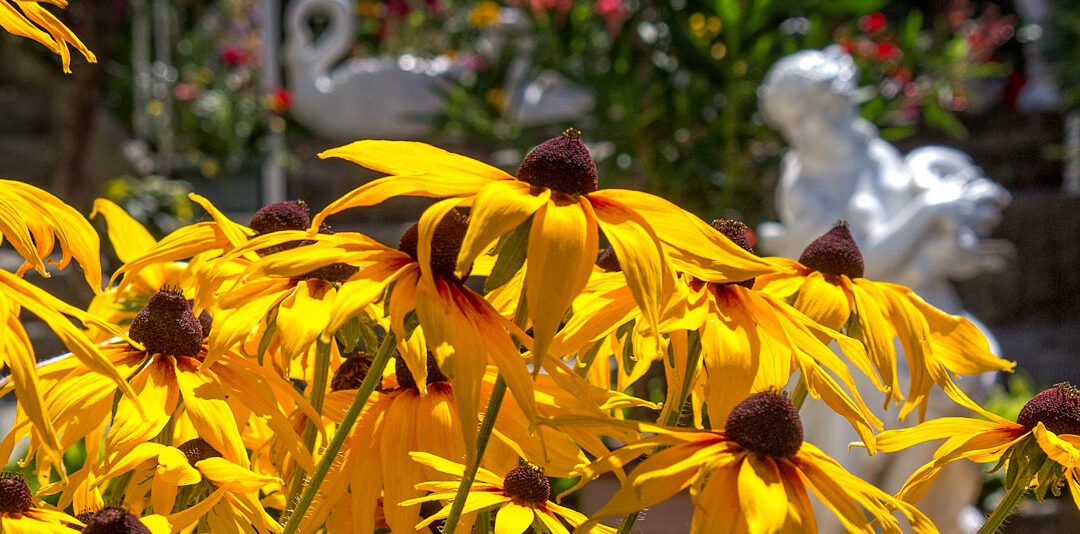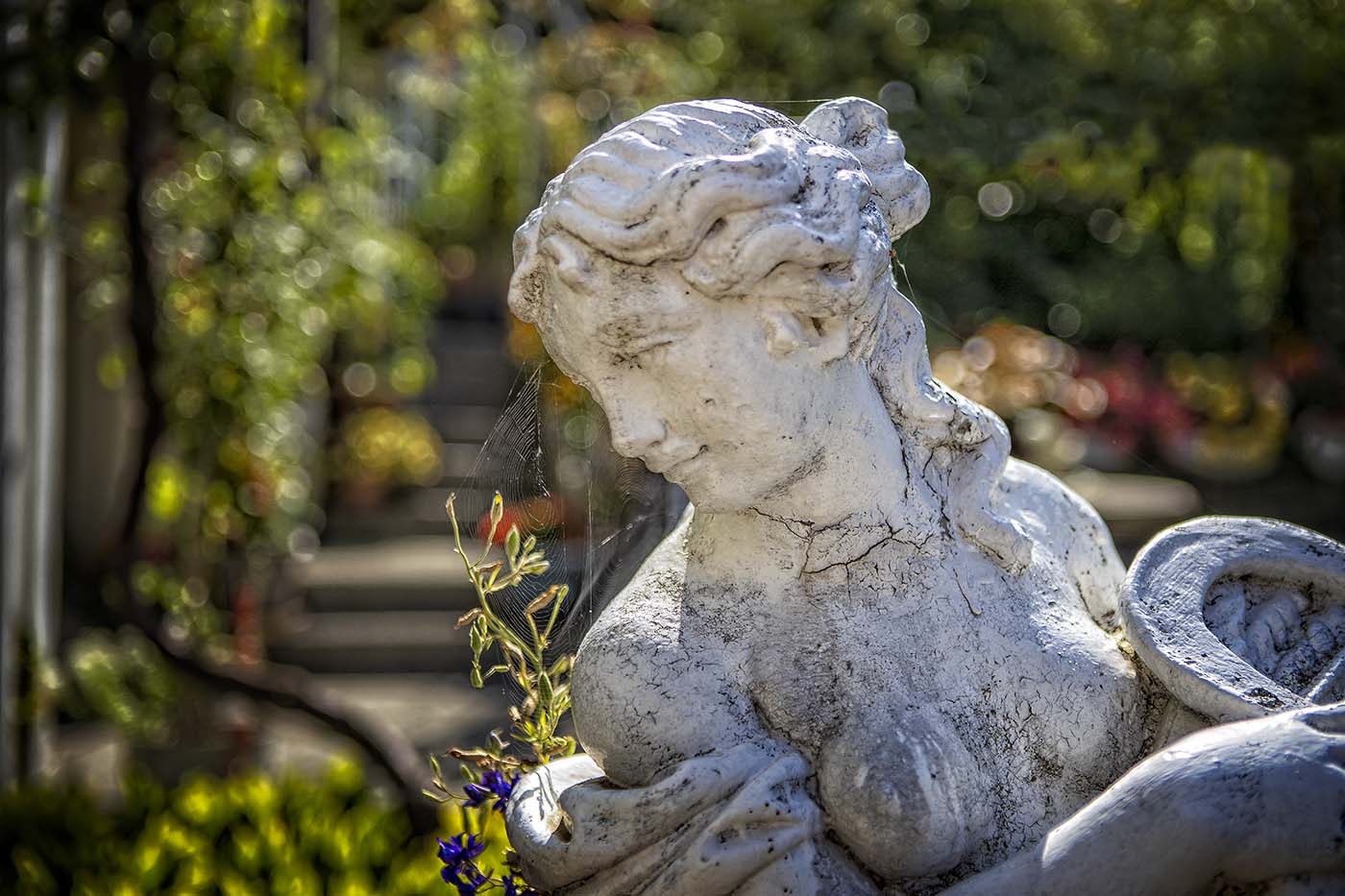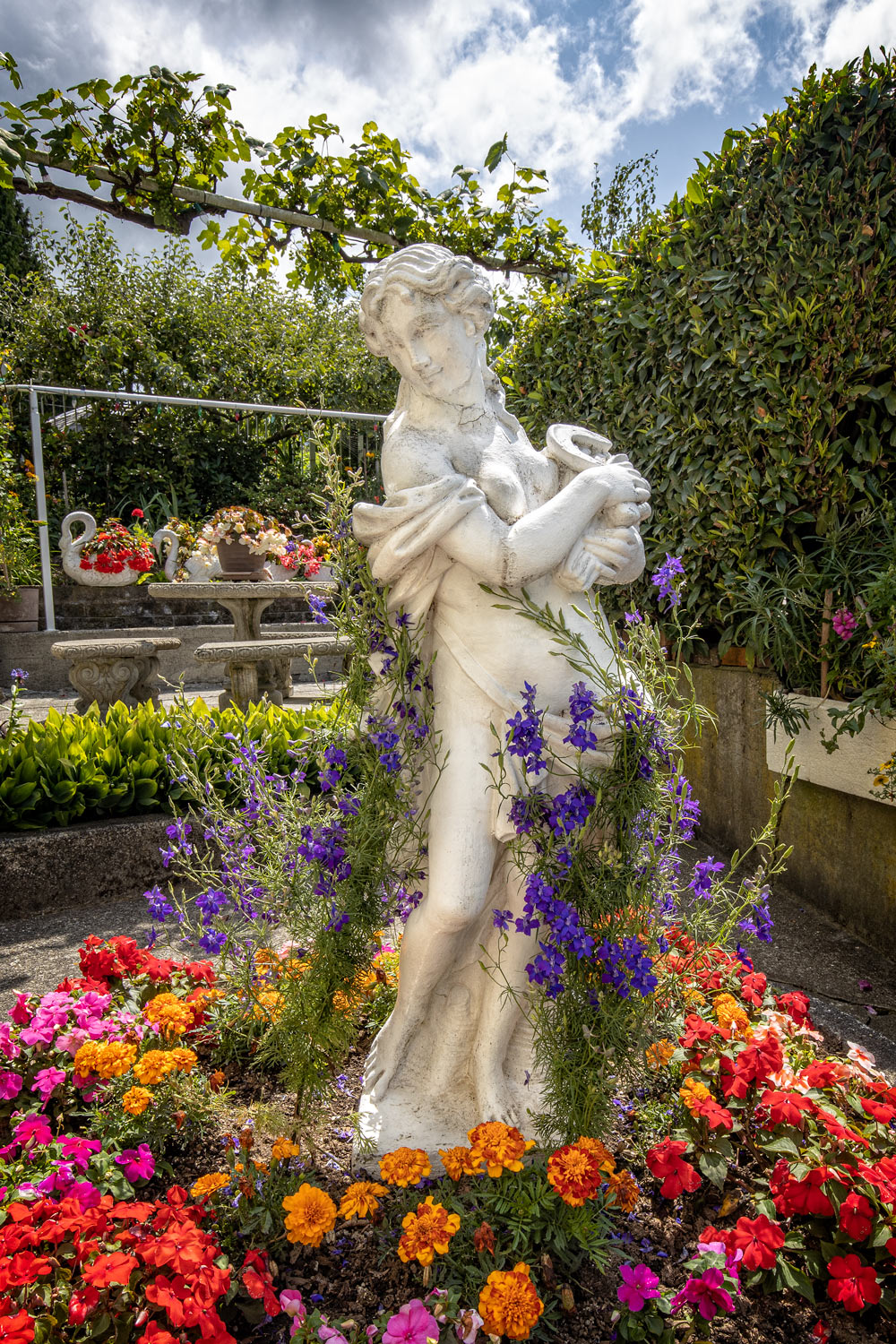On the side of the house we have a Lady who stands in the garden looking after the flowers. She is one of my favorite subjects.
Have you ever heard someone pondering what to photograph? I have and I have had the experience of making a suggestion only to be told that they have already photographed that. They say it as if there is only one picture to be taken of a thing and that once they have a picture they are done with it. Much like a collector saying “I have one of those already”.
This is a wrong headed way of looking at photography. I think maybe it comes from the unfortunate phrase we use when we speak of “taking” a picture. Of course, when it comes to artistic photography, there is no “taking” of anything involved in the process. It is more accurate to speak of the pictures we have “made” today.
We have in our garden at home a statue of a lady in a faux Greek or Roman style. I photograph her constantly and she is never the same. I use different cameras, different lenses, I go to her at different times of the day, in different seasons, in different weather. And I think I will be photographing her for years to come. But why?
The answer is because she is never the same. There is always something different about this Madonna dei Fiori every time I look at her. Although the subject is always the same the pictures are always different. And the challenge is to create an image that is not the same as the one yeaterday.
This is the same statue as the one above yet it could not be more different. The format is now horizontal, the predominant colors are greens and the feeling is much more intimate. It is a completely different picture but is of the same subject.
The whole impact of this picture is created by using a wide angle lens which emphasises the statue while allowing the flowers and the sky to appear in the picture at the same time.
I have many things and places that I retuirn to over and over to make my pictures. Sometimes I don’t feel there is anything new to be gained and other times I find the same thing has a completely new aspect because of the lighting, the season, the lens or camera.
The art comes from the seeing. So often people miss what is in front of them. And I think seeing only comes with practice. So many times I have taklen pictures, literally thousands of pictures, only to find the camera has not captured what I saw. Either the subject was too far away, or the light did not come across as I felt it, or the colors did not register the way I imagined them.
Sometimes it is the fault of the camera. Sometimes what we see is partially imagined or augmented by our senses to give us what we wanted to see. We are working with systems that do not reflect reality: they interpret it. Our senses translate what is in front of us according to our history. We know roses are red and so our brain tells us they are really really red telling us more of the color than is really there. Ours lenses and cameras do the same. The film or the image sensor record a very flat image based on an interpretation of neutral grey so that we get the best possible exposure and the maximum information. But, of course, our goal is not perfect exposure or that maximum information, it is something else all together. We want to deliver an emotional response to our picture. That is something that no machine can do.
The only way to learn how to cope with these issues is to take many many pictures and then to invest the time to analyse them. That way you learn the limitations of your gear and your senses. Seeing is not a simple thing. Our senses give us an interpretation of reality that our cameras do not see. Our cameras give us an interpretation of reality that our heart does not see. The
trick is to create our “art” using these less than perfect processes. We have to “see” what we can make of the scene before us.
Then, once we have recorded our photons, the work really begins. The “art” lies in processing the image so that it delivers to the viewer the impact the scene had on the photographer originally. And maybe more.
The wide angle lens can emphasis the head and shoulders of our Madonna by moving it higher and looking down more. Notice how distant the feet appear.
A completly different image is obtained if we use black and white film. The Madonna is rendered as she is in nature, white surface with black shadows, but the colorful flowers are drained of their color so they become patterns around the lady and they do not dominate the picture.
In post processing we try to put back the feeling that was lost by the camera and film/sensor. This is the part of the process that is more akin to drawing and painting than to photography. But it all starts with the quality of the image captured in the camera.
One of the reasons I have taken so many images of this statue is my continual playing with different cameras in the collection. This gives rise to different effects. Longer and shorter lenses change perspective and emphasis within the image. Simple lenses create artifacts in the image that can be very pleasing..
An example of simple lenses was my playing with the simple meniscus lens from a Brownie Hawkeye camera, which I wrote about earlier, That experimenting gave us a very pleasant image which you can see below, not too sharp, dissolving in the corners to a diffuse glow that I found delightful.
So, getting back to my original thesis, never assume that you have found the ultimate picture of an object or a scene. You have surely not. You can go back again and again to the same thing, the same location, and find something new. Move here. Move a few feet over there, Change your lens, Change your camera from digital to film, or back again. Experiment with simple lenses, even a common magnifying glass. See what happens.
The skill lies in the seeing, or, wondering what you would see if you did this or that. Once you have tried it you will add to your ability to “see”. And that increases the range and depth of your skill.
For this discussion I picked an object. Not far from our house is a forest path we walk on often I could have chosen that location instead of my Madonna in the garden. I have many pictures along that path. They are all the same but every one is different.

And finally, this image, of our Madonna dei Fiori. This was captured using the simple meniscus lens from a Brownie Hawkeye camera. Sharp in the middle and nowhere else but the result is pleasing. It captures what I felt that day in the garden enjoying Susan’s flowers.
This website is the work of R. Flynn Marr who is solely responsible for its contents which are subject to his claim of copyright. User Manuals, Brochures and Advertising Materials of Canon and other manufacturers available on this site are subject to the copyright claims and are the property of Canon and other manufacturers and they are offered here for personal use only.









